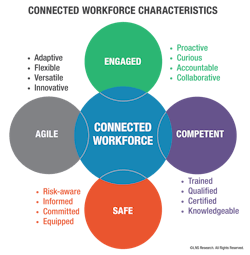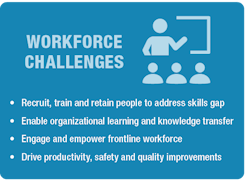Get Connected to Protect Frontline Workforce and Increase Operational Agility
“Industrial transformation or what we call IX is the digital transformation of industrial operations. Companies utilize IX as a strategic framework to drive step-change improvement and competitive advantage,” said Peter Bussey, research analyst at LNS Research. LNS Research is a Boston-based firm focused on industrial transformation research and analysis.
As part of industrial transformation initiatives, manufacturers have been increasingly building into their strategy the use of a connected workforce; using technology to improve productivity, increase communication, share real-time knowledge, address issues faster, and improve their bottom-line performance. Now, with the addition of a global pandemic, a digitally connected workforce is more important than ever before.
“Frontline workforce issues are among the top strategic priorities in industrial operations, specifically addressing a severe talent and skills shortage, and improvement of safety and EHS performance,” Bussey said. “The pandemic has preferentially accelerated these initiatives.”
In LNS Research’s recent report that focuses on enabling operational agility with a digitally connected workforce, Bussey points out that workplace safety is a prerequisite to smooth-running, profitable operations. This priority seems especially punctuated this year with a global health crisis and much strategizing on how to keep workers safe while keeping organizations open and working.
According to Bussey’s research, though safety is certainly an organizational concern, when it comes to safety and risk management on the frontlines, there’s a gap between strategy and actual execution. LNS Research shows that capabilities for safety and risk programs and processes are most often deficient. In a survey of 300 industrial organizational leaders/personnel conducted by LNS, 63% of respondents reported that they don’t have capabilities in place to effectively manage risk and safety.
With COVID-19 only adding to this stress on manufacturers, organizations struggled to respond to rapidly changing information, confusion, and concern. At the start of the pandemic, industrial organizations responded most commonly with the updating and addition of more personal protective equipment (PPE). However, as the crisis unfolded, greater emphasis has been placed on more permanent engineering and operational controls, such as re-configuring production process flows to improve physical distancing of personnel.
“Certainly, we’ve seen increased focus on digital technologies that include tools for remote expert access, better use of already-available collaboration tools, rapid development of new apps, vision systems, cobots, automated guided vehicles, and specialized connected worker tech, such as smart wearables to maintain distancing,” Bussey said.
Connected worker initiatives were already being explored and implemented by manufacturers as part of their industrial transformation. With the “new normal” created by a worldwide pandemic, Bussey believes this trend will only continue at an accelerated rate. Bussey recommends, “Connected worker initiatives should be a key pillar of operational strategy, directly contributing to the development of a safe, engaged, informed workforce, with the collaboration and agility needed to meet fast-changing requirements and new risks.”
Discover more at lnsresearch.com.
About the Author
Diane Sacra
Director of marketing, LNS Research

Leaders relevant to this article:


